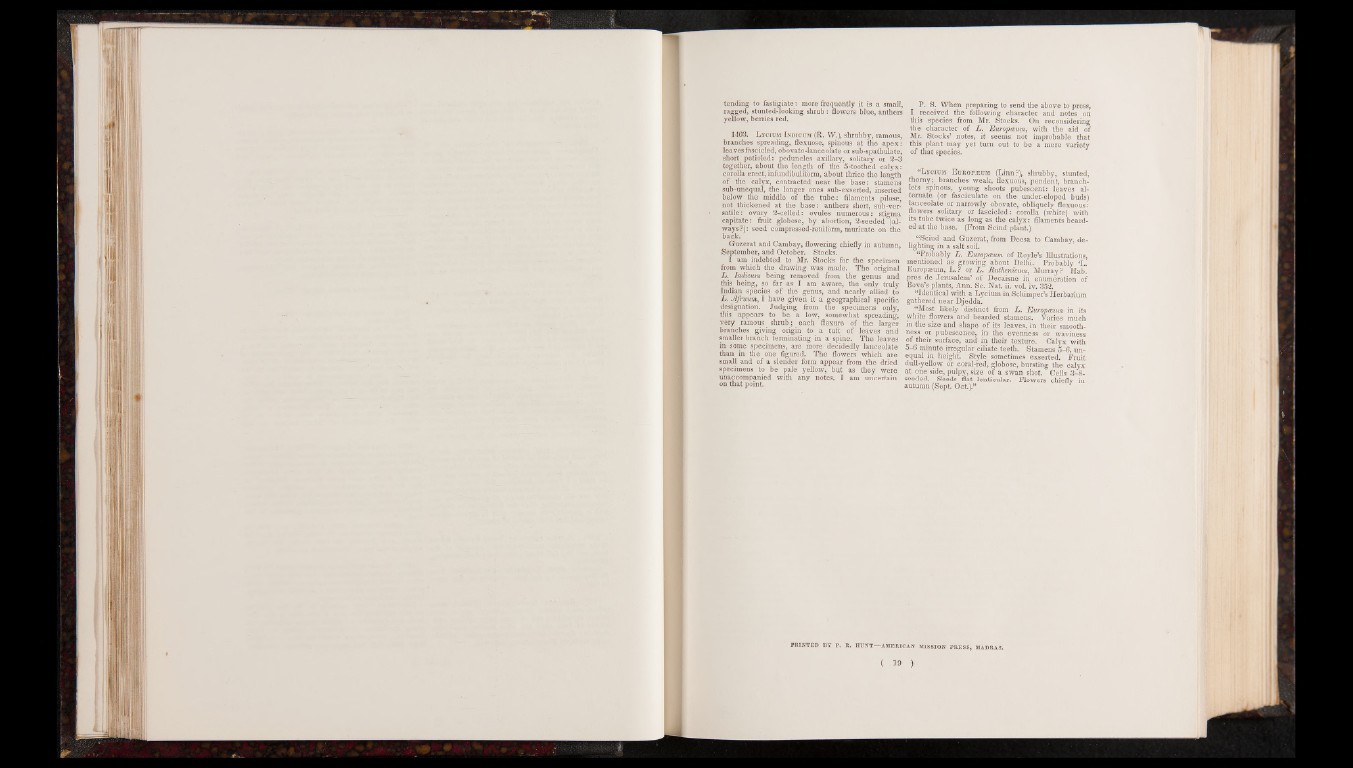
tending to fastigiate: more frequently it is a small,
ragged, stunted-looking shrub: flowers blue, anthers
yellow, berries red,
1403. Lycium Indicum (R. W.), shrubby, ramous,
branches spreading, flexuose, spinous at the apex:
leaves fascicled, obovato-lanceolate or sub-spathulate,
short petioled: peduncles axillary, solitary or 2-3
together, about the length of the 5-toothed calyx:
corolla erect, infundibuliform, about thrice the length
o f the calyx, contracted near the base: stamens
sub-unequal, the longer ones sub-exserted, inserted
below the middle o f, the tube: filaments pilose,
not thickened at the base: anthers short, sub-versatile:
ovary 2-celled: ovules numerous: stigma
capitate: fruit globose, by abortion, 2-seeded (always
?): seed compressed-reniform, muricate on the
back.
Guzerat and Cambay, flowering chiefly in autumn,
September, and October. Stocks.
I am indebted to Mr. Stocks for the specimen
from which the drawing was made. The original
L . Indicum being removed from the genus and
this being, so far as I am aware, the only truly
Indian species of the genus, and nearly allied to
L . Jlfruum, I have given it a geographical specific
designation. Judging from the specimens only,
this appears to be a low, somewhat spreading,
very ramous shrub; each flexure of the larger
branches giving origin to a tuft of leaves and
smaller branch terminating in a spine. The leaves
in some specimens, are more- decidedly lanceolate
than in the one figured. The flowers which are
small and of a slender form appear from the dried
specimens to be pale yellow, but as they were
unaccompanied with any notes, I am uncertain
on that point.
P. S. When preparing to send the above to press,
I received the following character and notes on
this species from Mr. Stocks. On reconsidering
the character of L . Europ&um, with the aid of
Mr. Stocks’ notes, it seems not improbable that
this plant may yet turn out to be a mere variety
of that species.
“Lycium Europeum (Linn?), shrubby, stunted,
thorny; branches weak, flexuous, pendent, branch-
lets spinous, young shoots pubescent: leaves alternate
(or fasciculate on the under-eloped buds)
lanceolate or narrowly obovate, obliquely flexuous:
flowers solitary or fascicled: corolla (white) with
its tube twice as long as the calyx: filaments bearded
at the base. (Prom Scind plant.)
“Scind and Guzerat, from Deesa to Cambay, delighting
in a salt soil.
“Probably L . Europccum of Royle’s Illustrations,
mentioned as growing about Delhi. Probably ‘L.
Europasum, L .? or L . JRuthenicum, Murray? Hab.
pres de Jerusalem’ of Decaisne in enumeration of
Bove’s plants, Ann. Sc. Nat. ii. vol. iv. 352.
“Identical with a Lycium in Schimper’s Herbarium
gathered near Djedda.
“Most likely distinct from L . Ewopceum in its
white flowers and bearded stamens, varies much
in the size and shape of its leaves, in their smoothness
or pubescence, in the evenness or waviness
of their surface, and in their texture. Calyx with
5 -6 minute irregular ciliate teeth. Stamens 5-6, unequal
in height. Style sometimes exserted. Fruit
dull-yellow or coral-red, globose, bursting the calyx
at one side, pulpy, size of a swan shot. Cells 3-8-
seeded. Seeds flat lenticular. Flowers chiefly in
autumn (Sept. Oct.).”
PRINTED BY P. R. HUNT—AMERICAN MISSION PRESS, MADRAS.
( 19 )